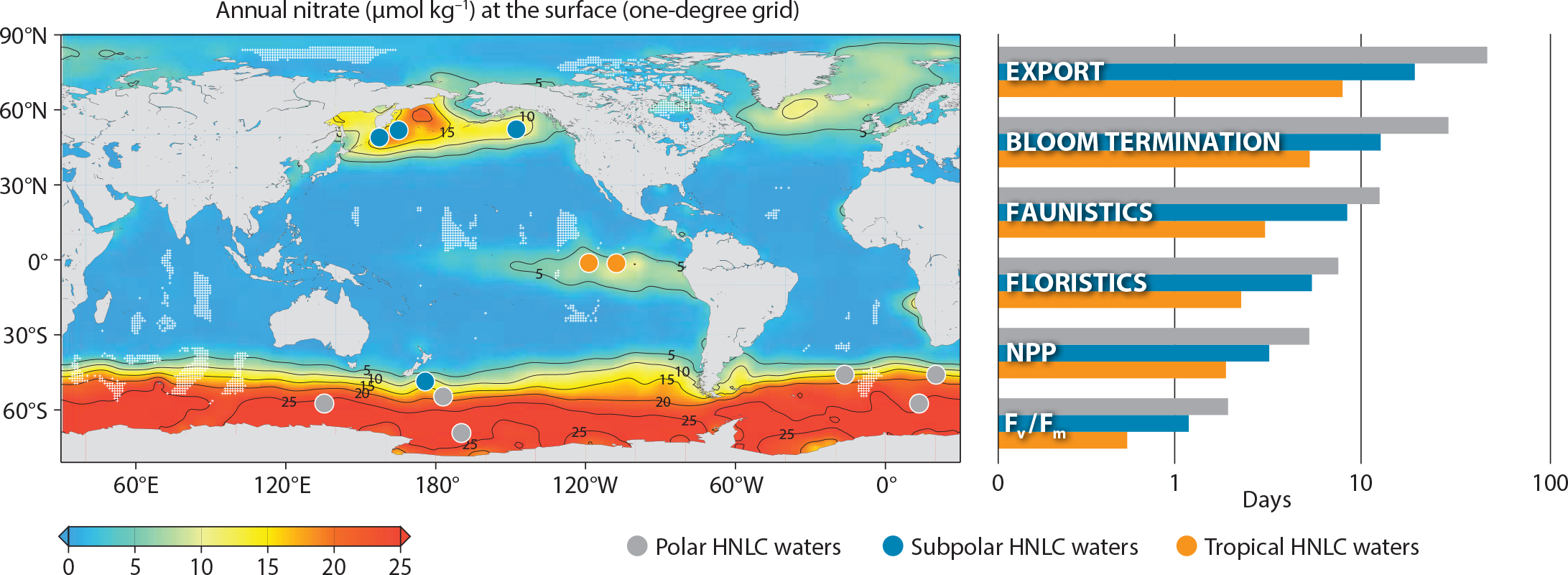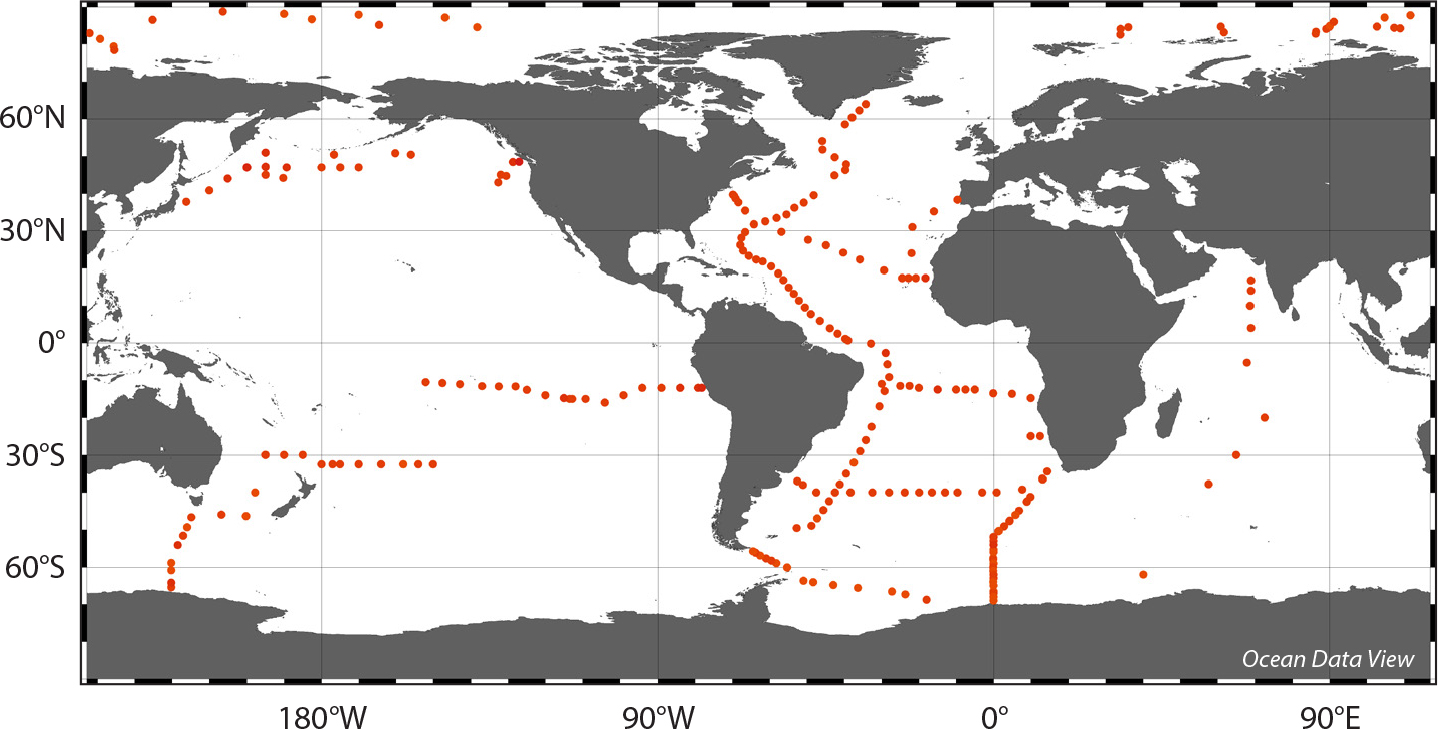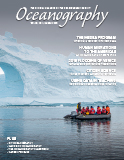Dedication. This article is dedicated to the late Keith Hunter, who passed away on October 24, 2018. Keith was a complex and wonderful person, a full-blooded researcher and brilliant scientist, and also the most down-to-earth person—digging up some potatoes in his garden or sitting down at home with a glass of good whiskey looking over the sea. Keith was one of the first chemical oceanographers to embrace John Martin’s hypothesis that iron is a limiting nutrient in many parts of the global surface ocean. In 1996, Keith and David Turner initiated and then co-chaired the very first of SCOR’s iron-related working groups, WG 109 on the Biogeochemistry of Iron in Seawater. Keith was an inspiring supervisor and mentor, a staunch supporter of great research, and an outstanding scientist, as reflected in his more than 150 publications, software innovations, and receipt of numerous science awards and prizes. He will live on in our memories, and the ideas he inspired in many of us will be his legacy.
Introduction
The founders of modern oceanography understood the global nature of the ocean system and concluded that ocean science research would be strengthened by collaborative efforts among ocean scientists from different nations. The 1957–1958 International Geophysical Year (IGY) highlighted what could be accomplished through international approaches to ocean science (Wolff, 2010). The International Council of Scientific Unions (ICSU) formed a Comité Special de l’Année Géophysique Internationale (CSAGI) for the IGY (Wolff, 2010). At this time, CSAGI was the only ICSU interdisciplinary committee; the only ICSU body related to ocean science was the International Association of Physical Oceanography (IAPO) of the International Union of Geodesy and Geophysics, now the International Association for the Physical Sciences of the Ocean (IAPSO). However, CSAGI was temporary, and IAPO primarily dealt with physical oceanography.
Consequently, ICSU (now the International Science Council) formed the Special Committee on Oceanic Research1 (SCOR) in 1957 as a longer-term organization to help ocean scientists worldwide work together to identify and pursue ocean research and solve methodological problems that hinder research. SCOR was formed by some of the same scientists who were leaders of CSAGI. Since its formation, SCOR has provided means to enlist the ideas, enthusiasm, and energy of scientists to increase knowledge of the ocean—knowledge that, in turn, is useful for addressing societal issues. SCOR’s success in promoting the importance of securing fundamental knowledge about the ocean offers clues to factors that are important for keeping such knowledge generation a healthy enterprise.
SCOR is based on a system of national SCOR committees. These committees pay dues to maintain the SCOR Secretariat and to support working groups and other SCOR activities. With this financial base, SCOR provides administrative support to its working groups and projects at no cost, as a service to the international ocean science community. Another key function of national SCOR committees is to nominate and elect officers for the SCOR Executive Committee, which is responsible for all SCOR activities.
SCOR’s main strength, and what makes it unique, is that it empowers individual scientists to gather together international groups to develop new research projects, form working groups, and manage projects related to the infrastructure of specific areas of ocean science. Most national funding agencies only support activities of scientists from or within their nations. SCOR’s funding has no national limitations, its activities range from very disciplinary to multidisciplinary, and they incorporate all areas of ocean science, from coastal waters to the deep sea, from research to observations to modeling and synthesis. No other international ocean science organization provides these broad opportunities to the ocean science community.
SCOR has helped advance many areas of ocean science via working groups and research projects initiated by the scientific community, including air-sea gas and material transfers; the equation of state of seawater; ocean carbon, including acidification; harmful algal blooms; pelagic fish populations and climate change; methods for phytoplankton and zooplankton identification and analysis; paleoceanography; trace elements and isotopes in the ocean, particularly iron; and many others (see https://scor-int.org/scor/achievements/). SCOR gave early attention to many topics that are now the central concerns of other organizations.
SCOR’s contributions to understanding the global iron cycle demonstrate the importance of “bottom-up” approaches to advancing science. SCOR activities have contributed to improved understanding of iron chemistry in seawater, iron effects on biota, and iron biogeochemistry. They have helped solve methodological issues related to measuring and modeling iron in the ocean and supported the generation and archiving of ocean iron data. Like many scientific advances, our understanding of iron biogeochemistry in the ocean evolved not only through research and development of techniques in individual laboratories but also through collaborations between international groups of scientists who contributed their experience, time, and other resources. Figure 1 places SCOR-supported work in the context of other activities in the field. SCOR-supported science has made possible revisions in the conceptual view of the marine iron cycle from WG 109 to the present.
1 SCOR’s name was later changed to Scientific Committee on Oceanic Research.

Figure 1. Timeline of SCOR contributions to advancing understanding of iron chemistry in seawater. Activities sponsored by SCOR are in blue. SCOR-sponsored working groups are in orange. Projects not supported directly by SCOR are gray. (a) Milestones reached in relevant global research projects and topics. BioGeoSCAPES (https://www.biogeoscapes.org/) is represented with a dashed arrow, as it is a developing project that could contribute new understanding of the role of organisms in the global iron cycle. (b) Major developments in advancing understanding of iron chemistry in the ocean, including contributions from SCOR-sponsored research projects and SCOR Working Groups. (c) SCOR-sponsored contributions to data.> High res figure
GEOTRACES: An international study of marine biogeochemical cycles of trace elements and their isotopes
IDP: Intermediate Data Product
IGAC: International Global Atmospheric Chemistry project (Future Earth)
IMBeR: Integrated Marine Biosphere Research Project (SCOR and Future Earth)
SAFe: Sampling and Analysis of Iron intercomparison exercise
SOLAS: Surface Ocean-Lower Atmosphere Study (SCOR, Future Earth, World Climate Research Programme, and international Commission on Atmospheric Chemistry and Atmospheric Pollution)
WG 109: Biogeochemistry of Iron in Seawater
WG 131: The Legacy of in situ Iron Enrichment: Data Compilation and Modeling
WG 135: Hydrothermal Energy Transfer and its Impact on the Ocean Carbon Cycles
WG 139: Organic Ligands – A Key Control on Trace Metal Biogeochemistry in the Ocean
WG 145: Modelling Chemical Speciation in Seawater to Meet 21st Century Needs (MARCHEMSPEC)
WG 151: Iron Model Intercomparison Project (FeMIP)
|
SCOR Working Group Contributions to Iron Studies
SCOR calls for proposals for new working groups annually and typically approves two new groups each year. Working groups advance specific areas of ocean science over a three- to four-year period by identifying priority science, coordinating international intercalibrations, identifying best practices, and working on obstacles that hinder their area of ocean science. New working group proposals are reviewed by national SCOR committees, which provide a significant portion of the funding for these groups, as well as by partner organizations and any interested scientists. To date, SCOR has contributed to advancing understanding of iron through six working groups (109, 131, 135, 139, 145, and 151—see definitions in Figure 1 caption). Several of the later working groups are built on the foundations provided by earlier groups, and many contributed to the research project GEOTRACES, described in the next section.
SCOR activity in relation to iron in the ocean started in 1996 with SCOR/International Union of Pure and Applied Chemistry (IUPAC) Working Group (WG) 109. The purpose of WG 109 was to document our understanding of iron chemistry in the ocean in the mid-1990s and to identify priorities for future research. This group was formed following the community’s recognition of iron as a key element in controlling ocean productivity (Martin and Fitzwater, 1988). The work of WG 109 was published in a book entitled The Biogeochemistry of Iron in Seawater (Turner and Hunter, 2001). WG 109 also led to an intercomparison of measurements of iron in seawater in a project called IRONAGES that involved 24 laboratories using seven different analytical techniques (Bowie et al., 2006). This intercomparison exercise found that although measurement capabilities had improved significantly in relation to previous intercomparisons (Bewers et al., 1981; Landing et al., 1995), the range of results was still unacceptably large among different laboratories.
SCOR WG 131, established in 2007, compiled data from nine of the 13 large-scale iron fertilization experiments conducted between 1993 and 2009 (Boyd et al., 2012; Figure 2) in order to make the data available for analyses of similarities and differences among the systems that could help explain the different ecosystem responses to iron additions in various regions.

Figure 2. Locations of in situ mesoscale iron enrichment studies in polar (gray symbols), subpolar (blue symbols), and tropical (orange symbols) high nitrate-low chlorophyll waters, along with a summary of the timescales of biological responses. The left panel overlays the location of each study on a map of global ocean surface nitrate concentrations. Nitrate concentrations courtesy of NOAA’s National Oceanographic Data Center. The right panel summarizes timescales of biological responses (log time scale, 0 denotes iron release), from photosynthetic to biogeochemical, following purposeful mesoscale iron enrichment. Fv/Fm is phytoplankton photosynthetic competence, and NPP denotes net primary production. Bloom termination is defined as the period during which a sustained decrease in bloom stocks is observed. Export is defined as enhancement of the downward flux of particles in the upper 300 m. The temporal trends demonstrate that different locales have characteristic response times. Data are available from the BCO-DMO relational database (https://www.bco-dmo.org/program/2017). Figure modified from Boyd et al. (2012). > High res figure
|
SCOR/InterRidge WG 135, formed in 2008, contributed to understanding and modeling of iron released from hydrothermal systems and its relation to organic carbon (German et al., 2015) by modeling data from the East Pacific Rise and applying it to known global hydrothermal venting.
SCOR Working Group 139 was convened in 2011 to bring together trace metal biogeochemists, organic geochemists, and biogeochemical modelers to improve our understanding of how metal-binding organic ligands affect marine biogeochemical cycles, including for iron. Outcomes of WG 139 included the publication of more than 50 research articles across two special journal issues, in Marine Chemistry (Lohan et al., 2015) and Frontiers in Marine Science (Buck et al., 2017).
SCOR WG 145 was established in 2014 in recognition of the need for freely available software to calculate chemical speciation of elements in seawater. This group has documented the currently available seawater speciation models that use Pitzer equations (Pitzer, 1991; Turner et al., 2016), which are considered to be the current state of the art for chemical speciation calculations in complex media such as seawater. WG 145 is developing web-based software to make it possible to determine the speciation of trace metals, carbonate ions, and other components of seawater.
SCOR WG 151 is extending the work of Tagliabue et al. (2016), which showed that global biogeochemistry models are not adequate or consistent in how they represent iron and processes involving iron. This working group aims to support the improved understanding of the role of iron in shaping large-scale biogeochemical cycles in global ocean models and their projected responses to climate change.
SCOR-Supported Research Projects—GEOTRACES Example
SCOR also provides mechanisms for groups of scientists to self-assemble around science topics that would benefit from a coordinated international approach; individual research projects are then funded by national funding agencies. SCOR convenes open science meetings on the designated topics to define priority research questions, forms planning committees using this input to create project science plans, and assembles scientific steering committees to manage the projects. Besides national support for project coordination, Australia, Canada, China, France, Germany, Poland, and the UK currently support international project offices and regional offices for SCOR research and other projects; these offices are vital for success of SCOR projects. SCOR currently supports five international research projects, and drawing on its long history in ocean science, helps ensure the transfer of lessons learned from completed projects to new projects.
GEOTRACES (http://www.geotraces.org/) provides an excellent example of how SCOR involvement can help assure project success. Based on international community and national funding agency interest in a new large-scale research project on trace elements and isotopes in the ocean, in 2004 SCOR supported the formation of a planning committee for a new project called GEOTRACES. (GEOTRACES had already held its own open science meeting with support from the US National Science Foundation, but SCOR helped support the planning committee to create a science plan based on the outputs from the open science meeting.) SCOR accepted GEOTRACES as one of its large-scale research projects in 2005 and worked with the project leaders to develop an international Scientific Steering Committee (SSC) and terms of reference for the program. For the duration of the project, SCOR approved appointments of members of the SSC, who were responsible for the project’s scientific direction, as well as any changes in the terms of reference.
Before an International Project Office (IPO) is established, and at no cost to the project or the national funding agencies, SCOR staff offer services that are normally provided by an IPO (e.g., administrative support, advice on meeting planning and logistics, communications), albeit at a reduced level. Since GEOTRACE’s IPO was formed, SCOR has handled many of the financial functions for the project, including fundraising for project meetings and offices, and has handled reimbursements for project meetings. SCOR has also provided advice on project strategies for communication, outreach, and capacity development. SCOR reviews each of its projects every five years; GEOTRACES has just received a very favorable review from an independent review committee. Given SCOR’s international reputation, research projects gain an intangible benefit from being SCOR-supported projects. There are no other international mechanisms to gather national support for planning and coordination of international ocean research projects.
GEOTRACES is the only SCOR project that is compiling a global data set. This data set is managed by a GEOTRACES Data Management Committee, which works with SCOR-supported staff (with funds from NSF and other sources) at the British Oceanographic Data Centre. The GEOTRACES project has vastly expanded the amount of iron data available in all ocean basins, from the surface to the seafloor (Lam and Anderson, 2018), made these data available in a relational database (see https://www.bodc.ac.uk/geotraces/data/idp2017/), and visually represented the data in the eGEOTRACES atlas (see http://www.egeotraces.org/). A total of 12,050 iron measurements are included in the 2017 GEOTRACES Intermediate Data Product (IDP; Schlitzer et al., 2018) (Figure 3). All iron data in the GEOTRACES IDPs have been thoroughly scrutinized through intercalibration and the analysis of reference samples, so that only high-quality measurements are included (Bowie and Tagliabue, 2018). Since 2016, further GEOTRACES section cruises and process studies have been carried out in the Atlantic, Indian, Pacific, and Southern Oceans, which will result in the addition of considerable iron data in the 2021 GEOTRACES IDP.

Figure 3. Locations of GEOTRACES stations with iron data, from the surface to the seafloor (IDP-2017; Schlitzer et al., 2018), including data through 2016. Figure courtesy of Reiner Schlitzer (AWI). > High res figure
|
Conclusions
SCOR, with its unique mandate to bring the international ocean science community together to formulate new ideas, has contributed to furthering our understanding of the ocean for more than 60 years. Bottom-up identification of important ocean science issues works because the community is the best arbiter of what issues need focused attention, and SCOR provides the mechanisms and funding to empower the community to implement its ideas. This approach has made it possible for segments of the ocean science community to self-organize to address issues that may not reach the level of “grand challenges,” but that need to be handled by some international organization to produce results that are accepted worldwide. The review process for SCOR working group proposals ensures that only the best ideas, those that are amenable to progress using SCOR mechanisms, are implemented.
The SCOR Executive Committee did not predetermine in 1996 to make iron in the ocean a major theme of SCOR work for the next 24 years, but the set of activities approved and funded by SCOR have done just that. The spacing of these activities over a 24-year period allowed each activity to build on the successes of previous activities and reflected development in underlying science being conducted by the global community. It is likely that SCOR will continue to support working groups on aspects of iron in the ocean as long as scientific and methodological issues require international attention. This example extends across many other topics to which SCOR has contributed. If SCOR did not exist, there is no other mechanism to combine financial resources from 31 countries to address important ocean science issues identified by the international community.
Acknowledgments
SCOR is supported by 31 national SCOR committees, several hundred scientists who volunteer their time to support SCOR work, national funding agencies such as the US National Science Foundation that support SCOR working groups, many national institutions and agencies that support international project offices for SCOR activities, and several charitable foundations. The International Atomic Energy Agency is grateful to the government of the Principality of Monaco for the support provided to its Environment Laboratories.




